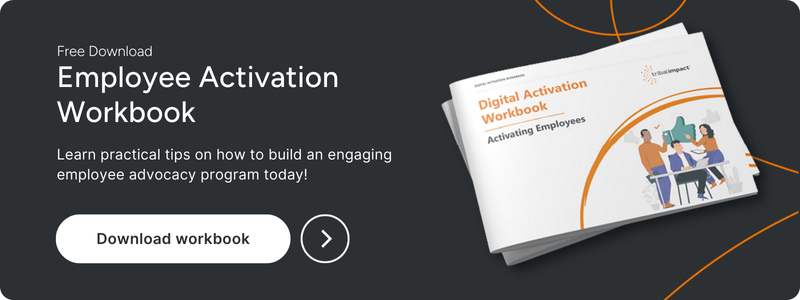
A broken employee advocacy programme can feel like it’s impossible to fix, but it doesn’t have to be. It’s all about change management and getting employees to understand the benefits of using platforms like LinkedIn.
Here are some tips on how to fix broken employee advocacy.
Install A Digital Culture
To implement a successful employee advocacy programme, it’s about change management. You need to install a digital culture where people understand the benefits and are motivated to join in.
The biggest challenge is taking the time to actually do this.
Nobody has to start BIG. They could start with just five minutes a day, reading trending topics on LinkedIn. The lower the barrier to entry, the more likely they are to get involved.
And the more employees see their peers doing it, the more it will get them interested and wanting to learn more, too. It may be a slow burn, but peers learn from each other.
Use The Right Tool
It’s all very well and good telling employees to use something, but they need to understand what the benefits of using it are for them.
Once they understand these benefits, you can teach them how to use it, and they’ll be more likely to do so because they understand the reasons behind it.
Think about the features you need when looking for a tool. How easy is it to manage content coming into the platform? Does it have tags? What metrics does it offer?
Every organisation will have different needs. You need to find a platform that allows for better growth and management, and that makes it easy for employees to find good, shareable content.
If anyone who adds content and manages the platform finds it difficult to use, it’ll slow them down and may prevent them from doing their role efficiently. Then, everything falls back on the shoulders of one person, making the whole thing unscalable.
Train Employees To Become Advocates
Training is really important. Employee advocacy isn’t something you can set and forget and hope for the best. It takes being consistent and engaged. You have to believe in it to see the results.
But remember – not everyone is ready to become an advocate. Don’t waste time trying to convince everyone. Focus on working with those who are understanding and want to be part of it.
Don’t Treat It Like An Amplification Programme
Many companies go wrong with this step. They see employee advocacy as a way to shout about themselves, rather than a way to put employees at the forefront.
The best employee advocacy programme offers employees a place where they can learn, and where they can share what’s interesting to them and their peers.
Data can help you discover what content resonates with employees’ audiences. What they share may not be what their network engages with, or what they click on.
Metrics should therefore be a big part of any platform you use. You need to be able to dig into what’s working. Find out what’s branded, what isn’t, and how those two types of content perform.
Also consider what gets more – or less – engagement, how content is consumed, and what type performs well.
All these little learnings, beyond ‘how’s my advocacy platform doing?’ will help you find what you should be doing more of going forwards.
Remind Employees What‘s In It For Them
Employees are more likely to engage and stick with the program when they understand how it's benefiting them.
Every employee will have a different reason to be active online, to build their professional brand, to be recognised for their expertise, to deepen relationships with their stakeholders, etc.
Once employees understand what’s motivating them to be active online, it will be easier for them to prioritise the program and regularly use professional social media.
Let Employees Be Authentic
Your employees know their audience best. It’s important that they add their industry insight to the platform so that they can share what they find interesting, and their audience starts to trust their thought leadership.
It’s about inspiring employees to find their story, recognise what they’re passionate about, and home in on that.
Social media is a great way to find like-minded people, as there are niche communities for almost everything.
But, if the employee advocacy platform isn’t engaging, it won’t work. Employees need to see the benefit for themselves, their network, their community, and their tribe.
It’s also important for them to engage with users in other locations. What’s popular in one location may not be in another. Engaging with people from other locations can help them spot upcoming trends and notice cultural differences.
Encouraging employees to submit content to the advocacy platform is also a great way to get them to engage – they’ll feel like they have a say on what gets accepted into the platform.
Be Consistent
Some employee advocates post once a week, some once a month. And they still get tens of thousands of engagements – because they’ve created a niche which resonates with their audience.
That’s why an advocacy programme that’s relevant to users is important. They’ll engage with it, keep coming back to it, share its content, and suggest content for it, too.
Employees could even schedule content in so that they don’t need to do it natively on LinkedIn.
Make It Scalable
You need to build out a team to support your programme and scale it up. These people don’t have to be from marketing – they could be anyone. After all, the platform is theirs. If they can’t find interesting content to share, they’re not going to use it.
It can sometimes help to include employees from a range of departments, because they’ll be interested in different niches, industry-related publications, and have different areas of expertise.
If you keep pushing content and telling them how to promote it, employees will push back and won’t log on because there isn’t anything of interest to them.
Create Channel Managers
Create different groups based on regions, countries, and sectors. You can then have a platform admin/company admin, and, within each group, different people in charge to manage, filter, and moderate the content that employees suggest.
These channel managers will need to be trained to understand what type of content can be shared externally. Maybe some pieces will be great internally, like analysis or more corporate content, but less interesting to LinkedIn followers.
If you can divide and conquer in this way, you’ll be able to do a lot more.
Measure Success
Most people focus on how much traffic advocacy drives to the website. Things like reach, visibility, number of clicks, shares, and number of reactions. This isn’t the only way to measure success, though.
It also helps to consider the engagement of employees on the advocacy platform. How often are they logging in, reading content, and sharing it?
Don’t forget platform metrics, either. What do those tell you?
The main objective should be to take the conversation offline – get the phone picked up and have leads talk about what they’d like the company’s help with.
Conclusion
When employees share content, it reflects who they are, and this reflects back a culture of trust within the organisation. This can help to build its employer brand, helping to attract better-quality candidates and reducing time to hire.
Employees need to be the starting point for any advocacy programme, though. You need to put them front and centre because they’re the experts who differentiate your brand.
Be confident with this and showcase it. The collective of individual voices is what makes a brand stronger.


